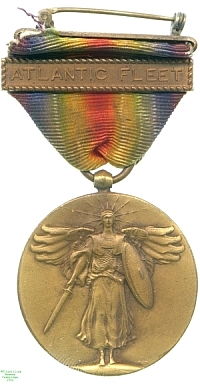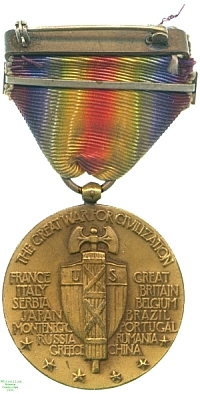
Obverse, Liberty with sword and shield standing atop a disc

Reverse, the arms of the USA done as a totem pole with a double-headed axe at the top

Obverse, Liberty with sword and shield standing atop a disc |

Reverse, the arms of the USA done as a totem pole with a double-headed axe at the top |
When the Great War of 1914-1918 had ended, there was a genuine feeling among the victorious Allies that their military efforts had been instrumental in preserving modern civilization, and this and the united spirit of the Alliance were commemorated in a combined issue of medals to those who had seen active service during the conflict. 13 nations in all issued a variety of this medal; all shared the rainbow ribbon and suspension, and all but the Japanese, who lacked a comparable symbolic figure, used a form of Victory on the obverse and a legend on the reverse.
The United States was alone among the issuing nations in issuing campaign and battle clasps along with the medal, 47 different ones being authorised to cover all the theatres in which United States personnel had been involved.
The medal was issued unnamed, and it is not known to whom this example was awarded, but the bar for the Atlantic Fleet thus identifies him as a member of the United States Navy's forces engaged against Germany, serving between 25 May and 11 November 1918. Lester Watson purchased the medal from the London dealers Baldwin at some point before 1928.